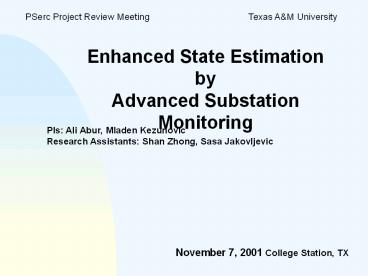Substation Model Implementation PowerPoint PPT Presentation
1 / 16
Title: Substation Model Implementation
1
PSerc Project Review Meeting
Texas AM University
Enhanced State Estimation by Advanced Substation
Monitoring
PIs Ali Abur, Mladen Kezunovic Research
Assistants Shan Zhong, Sasa Jakovljevic
November 7, 2001 College Station, TX
2
Outline
- Objectives
- Technical Approach
- Implementation
- Results
- Conclusions
3
Objectives
- Utilization of CPU and Data Acquisition
Capabilities at the Substations - Application Topology Error Detection and
Identification - Integration of Substation Processor and the EMS
State Estimator - Effects of Unbalanced Operation on Estimated State
4
Technical Approach
- Pre-process substation measurements
- Develop a two-stage state estimator
- Conventional model first stage
- Expanded model second stage
- Validate performance for topology errors
- Investigation of other error sources unbalanced
operation - GUI Development and testing
5
ImplementationSubstation Monitoring/
Measurement Processing
- Processing consistency check algorithms
- Substation measurement simulation software
6
Substation Model
- SIMULINK part of the model
- Simulation of substation measurements
- Voltage measurements
- Current measurements
- Contact status
- measurements
- Exporting simulation data into file
- MATLAB part of the model
- Data preparation
- Description of the measurement placement
topology - Consistency check using developed algorithms
- Exporting substation State Estimation results to
tables
7
State Estimator
- First Stage
- Uses LAV method to estimate the state of the
system - Normalized residuals are used to decide on the
suspect substation(s) if there exist any. - Second Stage
- Uses detailed models for the suspect substations
- Advanced substation state estimation of suspected
substation represented in detail - Enhancing the state estimation of overall power
network by including substation data
8
Interaction between System SE and Substation SE
- Exchanging data
- Conventional residual calculation and
determination of suspected substation - Advanced substation state estimation of suspected
substation represented in detail - Enhancing the state estimation of overall power
network by including substation data - Program for data conversion (interfacing)
- Converts data in real time after each data
snapshot - Utilizes the established format for data exchange
9
TestingTypes of Topology Errors
- Type1 Merged Bus
- The correct status of the CB is closed, but it
is assumed to be open. - Type2 Split Bus
- Opposite case of type 1 error.
- Type3 Line Outage
- The correct status of line end CB is closed,
but assumed to be open. - Type4 Line in Service
- Opposite case of type 2 error.
10
Library of Topology Errors
- Based on IEEE 30 bus system
- 50 Cases of different kinds of scenarios
11
Performance Evaluation
- Type 2 and type 3 errors are easily identified
- Methods that utilize the normalized suspect
measurement incidence index perform better - Limiting the number of suspect measurements also
improves the performance - All the cases can be identified by slightly
increasing the maximum suspect substation number
12
Graphical User Interface for the Two-Stage State
Estimator
13
GUI Features
- Creation of substation model from scratch
- Creation of a substation model using the template
- Automatic Generation of Substation Measurements
14
Three Phase State Estimator
- Features
- Three phase measurements
- Structural unbalances (tower geometry) are
modeled - Unbalanced loads/generation are modeled
- Utilization
- Study the effects of neglecting unbalances in
SPSE - Study the feasibility (practicality) of its
utilization from the view point of network data
and measurement requirements
15
Observations
- Under certain cases, the use of single-phase
state estimator may lead to significant biases in
the solution due to existing asymmetries or load
unbalances. - A higher sensitivity is observed of the system
state to loading unbalances than to asymmetries
in the transmission line conductor configurations
16
Conclusions
- Substation measurement pre-processor improves the
central State Estimator performance - Three phase unbalances are potential sources of
error and should be considered - Synchronized measurements between substations can
improve the benefits of the pre-processing
function

